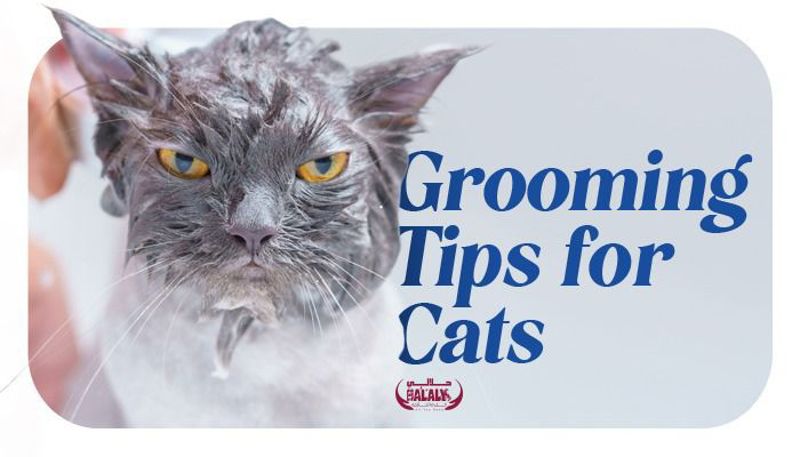Do you intend to welcome a new member to your family? Are you ready to receive this amount of love, fun, and kindness all at once?
If you are about to welcome a new cat into your life, or even if you have been a cat owner for a long time, this blog will help you gain a deeper understanding of the needs of cats, and the Essential Grooming Tips for Cats that every cat owner and cat lover needs to know.
Welcoming a cat into your home is a joyful and exciting experience. Whether you're a first-time cat owner or looking to refresh your knowledge, understanding the basics of cat grooming is essential. This guide aims to provide you with practical and effective grooming tips, ensuring your cute friend remains happy, healthy, and well-groomed.
What Are The Essential Grooming Tips for Cats?
Cats are known for their self-grooming habits. However, as a responsible pet owner, it's important to supplement their natural grooming with regular care. This includes brushing, nail trimming, and ear cleaning, among other practices.
1. The Importance of Regular Brushing
Brushing your cat regularly helps to remove loose hair, dirt, and debris. It also prevents matting and reduces hairballs. For long-haired breeds, daily brushing might be necessary, while short-haired cats can be brushed less frequently.
Choosing the Right Brush
Select a brush that suits your cat’s fur type. For short-haired cats, a fine-toothed comb or a rubber grooming mitt works well. Long-haired breeds may require a slicker brush or a wide-toothed comb.
2. Nail Care: Tips for Safe Trimming
Trimming your cat's nails is crucial to prevent overgrowth and potential injury. It's advisable to introduce nail trimming early in your cat’s life to make it a stress-free experience.
How to Trim Cat Nails
Gently press on your cat's paw to expose the nails. Use a dedicated cat nail trimmer and avoid cutting into the quick, which can cause bleeding and discomfort.
3. Ear Cleaning: A Gentle Approach
Regularly checking and cleaning your cat’s ears is important to prevent infections and ear mites. Use a soft, damp cloth or a cotton ball to gently clean the outer ear.
Signs of Ear Problems
Be alert to symptoms like excessive scratching, head shaking, or a bad odor, which could indicate an ear issue.
4. Dental Care for Cats
Oral health is often overlooked in cats. Brush your cat’s teeth regularly with a cat-specific toothbrush and toothpaste to prevent dental diseases.
5. Bathing Your Cat: When and How
While most cats don't require frequent baths, regular bathing might be necessary, especially for cats who can't groom themselves properly.
Tips for a Stress-Free Bath
Use a cat-friendly shampoo and keep the water at a lukewarm temperature. Always reward your cat after a bath to create a positive association.
Handling Grooming Challenges
Flea and Tick Prevention: A Key Grooming Task
Protecting your cat from fleas and ticks is a crucial aspect of grooming. Regularly check your cat's fur for these parasites. Use vet-recommended flea and tick treatments or collars. Preventative care not only keeps your cat healthy but also aids in maintaining a pest-free home.
The Art of Cat Grooming: Building Trust and Bonding
Grooming sessions are more than just maintenance; they're opportunities for bonding. Be gentle and patient, especially with cats new to grooming. Reward your cat with treats and affection to create a positive experience. Over time, grooming can become a cherished routine for both of you.
Managing Matting: A Challenge for Long-Haired Cats
Matting can be a significant issue, particularly for long-haired breeds. Prevent mats by regular, thorough brushing. If mats do form, gently tease them apart with your fingers or a comb. If mats become unmanageable, seek professional help.
Eye Care: An Often-Forgotten Grooming Aspect
Regularly check your cat's eyes for any signs of discharge or irritation. Gently wipe away any crust with a soft, damp cloth. Use a different area of the cloth for each eye to avoid cross-contamination. If you notice any changes in your cat's eyes, consult your vet.
Essential Grooming Practices You Should Care For
Seasonal Grooming: Adapting to Your Cat's Needs
Cats' grooming needs can change with the seasons. In warmer months, they may shed more, requiring frequent brushing. During colder months, they may need additional moisturizing treatments for their skin. Stay attentive to these seasonal changes to keep your cat comfortable year-round.
The Role of Diet in Cat Grooming
A nutritious diet plays a vital role in your cat’s coat and skin health. Ensure your cat gets balanced meals with essential fatty acids, which promote a shiny, healthy coat.
Professional Grooming: When to Consider It
Consider professional grooming for long-haired breeds or if your cat is particularly resistant to grooming at home. Professional groomers can handle the more challenging aspects of grooming with ease and expertise.
Concluding Thoughts on Cat Grooming
Effective grooming is about consistent, gentle care. Tailor your approach to your cat's specific needs and temperament. With the right tools and techniques, grooming can enhance your cat's health and deepen the bond you share. Remember, if you ever have concerns or questions about grooming, your veterinarian is an invaluable resource.























































